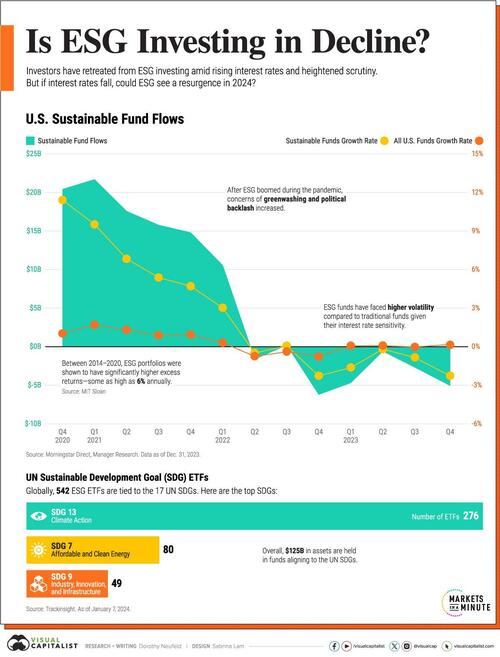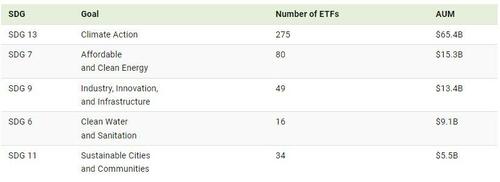
These days, ESG investments have lost their luster given high interest rates, political backlash, and greenwashing scrutiny.
In 2021 during the pandemic boom, U.S. sustainable funds hit a record $358 billion in assets, up from $95 billion in 2017. But since then, investor interest has waned as higher borrowing costs impact capital-intensive clean tech stocks.
This graphic, created by Visual Capitalist's Dorothy Neufeld, shows the drop in sustainable fund flows—often considered an indicator of investor sentiment—based on data from Morningstar.
Slowing Demand
In 2023, investor appetite cooled for sustainable investments, as fund flows notched their worst year on record.
Overall, flows sank $13 billion as fund performance lagged behind conventional funds. Adding to this, concerns surrounding the murkiness of environmental, social, and governance (ESG) ratings were put under the spotlight.
As ESG pushback intensified in U.S. politics, at least 165 anti-ESG bills were introduced in 2023. Politicians have claimed that ESG criteria negatively impacts financial returns, but evidence behind that is mixed.
While sustainable funds underperformed traditional funds in 2023, a separate study showed that ESG portfolios had as much as 6% excess returns annually compared to benchmark indexes between 2014 and 2020.
ESG Investments: A Closer Look
One key aspect of ESG funds is whether they hold investments that align with the UN Sustainable Development Goals (SDGs).
Globally, 542 funds with $125 billion in assets are associated with at least one of these objectives. The table below shows the top five SDGs, by ETF assets under management (AUM).
Source: Trackinsight. As of January 7, 2024.
We can see that Climate Action is the highest overall, with companies held in these ETFs making commitments to lower emissions and advance sustainability.
For instance, Home Depot has cut electricity use by over 50% since 2010 in U.S. stores, and aims to use renewables for all of its electricity by 2030. In addition, Microsoft has committed to this goal through a number of initiatives, including providing access to clean water to over one million people across Indonesia, Brazil, India, and Mexico in 2023.
While investor interest has slowed, 35% of advisors said they used ESG funds last year, based on a Journal of Financial Planning survey. As the industry matures, it remains to be seen if ESG investments will see a resurgence, especially if interest rates fall in the coming years.
These days, ESG investments have lost their luster given high interest rates, political backlash, and greenwashing scrutiny.
In 2021 during the pandemic boom, U.S. sustainable funds hit a record $358 billion in assets, up from $95 billion in 2017. But since then, investor interest has waned as higher borrowing costs impact capital-intensive clean tech stocks.
This graphic, created by Visual Capitalist’s Dorothy Neufeld, shows the drop in sustainable fund flows—often considered an indicator of investor sentiment—based on data from Morningstar.
Slowing Demand
In 2023, investor appetite cooled for sustainable investments, as fund flows notched their worst year on record.
Overall, flows sank $13 billion as fund performance lagged behind conventional funds. Adding to this, concerns surrounding the murkiness of environmental, social, and governance (ESG) ratings were put under the spotlight.
As ESG pushback intensified in U.S. politics, at least 165 anti-ESG bills were introduced in 2023. Politicians have claimed that ESG criteria negatively impacts financial returns, but evidence behind that is mixed.
While sustainable funds underperformed traditional funds in 2023, a separate study showed that ESG portfolios had as much as 6% excess returns annually compared to benchmark indexes between 2014 and 2020.
ESG Investments: A Closer Look
One key aspect of ESG funds is whether they hold investments that align with the UN Sustainable Development Goals (SDGs).
Globally, 542 funds with $125 billion in assets are associated with at least one of these objectives. The table below shows the top five SDGs, by ETF assets under management (AUM).
Source: Trackinsight. As of January 7, 2024.
We can see that Climate Action is the highest overall, with companies held in these ETFs making commitments to lower emissions and advance sustainability.
For instance, Home Depot has cut electricity use by over 50% since 2010 in U.S. stores, and aims to use renewables for all of its electricity by 2030. In addition, Microsoft has committed to this goal through a number of initiatives, including providing access to clean water to over one million people across Indonesia, Brazil, India, and Mexico in 2023.
While investor interest has slowed, 35% of advisors said they used ESG funds last year, based on a Journal of Financial Planning survey. As the industry matures, it remains to be seen if ESG investments will see a resurgence, especially if interest rates fall in the coming years.
Loading…





